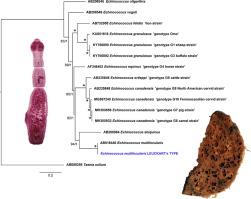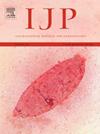Rediscovery of a name-bearing type of Echinococcus multilocularis (Leuckart, 1863) by museum forensics: a cold case revisited
IF 3.2
2区 医学
Q1 PARASITOLOGY
引用次数: 0
Abstract
We report on the rediscovery of a presumably lost type specimen of Echinococcus multilocularis (Leuckart, 1863). The study establishes the mitochondrial genome of E. multilocularis from a historical syntype specimen and explores modern genomic techniques to clarify its identity in European populations. Despite initial failure in nested PCR, high-throughput next-generation sequencing (NGS) successfully assembled the mitochondrial genome from post-capture reads, revealing a 13,738 bp sequence. This genome contained 12 protein-coding genes, 2 rRNA genes, and 22 tRNA genes. Phylogenetic analysis placed E. multilocularis in a clade with E. shiquicus. Comparison of mitochondrial sequences confirmed a 100% identity with modern isolates from western-central Europe, demonstrating the persistence of this lineage over 200 years. The study emphasises the value of museum specimens and advanced genomic techniques in historical taxonomy, showcasing the synergy of forensic museum research and modern DNA technologies. This research stabilises the nomenclature of E. multilocularis and therefore contributes to better understanding its epidemiological role in human disease.

博物馆法医重新发现一种多房棘球蚴(Leuckart, 1863):重访一宗悬案。
我们报告了一个可能丢失的多房棘球蚴类型标本的重新发现(Leuckart, 1863)。该研究从一个历史的模式标本中建立了多房棘猴的线粒体基因组,并探索了现代基因组技术来澄清其在欧洲人群中的身份。尽管巢式PCR最初失败,但高通量下一代测序(NGS)成功地从捕获后的reads组装了线粒体基因组,揭示了一个13,738 bp的序列。该基因组包含12个蛋白质编码基因、2个rRNA基因和22个tRNA基因。系统发育分析将多室蠓与石基蠓归为一个分支。线粒体序列的比较证实了与来自西欧和中欧的现代分离株的100%的一致性,表明该谱系的持久性超过200年。该研究强调博物馆标本和先进基因组技术在历史分类学中的价值,展示了法医博物馆研究和现代DNA技术的协同作用。这项研究稳定了多房棘球绦虫的命名,因此有助于更好地了解其在人类疾病中的流行病学作用。
本文章由计算机程序翻译,如有差异,请以英文原文为准。
求助全文
约1分钟内获得全文
求助全文
来源期刊
CiteScore
8.40
自引率
2.50%
发文量
76
审稿时长
23 days
期刊介绍:
International Journal for Parasitology offers authors the option to sponsor nonsubscriber access to their articles on Elsevier electronic publishing platforms. For more information please view our Sponsored Articles page. The International Journal for Parasitology publishes the results of original research in all aspects of basic and applied parasitology, including all the fields covered by its Specialist Editors, and ranging from parasites and host-parasite relationships of intrinsic biological interest to those of social and economic importance in human and veterinary medicine and agriculture.

 求助内容:
求助内容: 应助结果提醒方式:
应助结果提醒方式:


